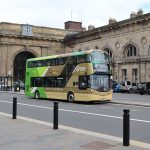Climate outrage has spurred a panoply of strict clean air measures across urban UK areas. Should rural operators also be ready for change? Heron Travel of Kendal believes so
Clean air is one of the pressing issues of 2019. The regulation of polluting vehicles has been one constant in an era of political dispute – Near all parties can agree that pollution is unacceptable, with one report estimating that particulate matter alone brings a health cost to UK society of around £16 billion.
London has been a pioneering force in cleaning up its tail pipe emissions – first with the Congestion Charge Zone, which aimed to reduce traffic volume, then with the introduction of the toxicity charge and this year the controversial Ultra Low Emission Zone (ULEZ).
City Hall claims the measures in London have resulted in thousands of drivers upgrading to newer, compliant vehicles.
Clean Air Zones (CAZs) and Low Emission Zones in Scotland have been announced to combat road traffic pollution outside London. These include cities such as Sheffield, Manchester, Birmingham and Edinburgh. York, Leeds and Glasgow now have a one of the zones either confirmed or already in force, with Leeds charging £50 for non-compliant coaches and buses.
That the proposed zones seem exclusive to larger towns and cities should come as little surprise, as this is naturally where slow-moving traffic – especially bus traffic – is centred.
But outside of the cities, air pollution remains a concern. While there seems to be little discussion about enforcement of CAZs in the UK’s smaller towns and pastoral regions, operators should be wary of this changing when cities become cleaner and the focus moves.
Clean air for the countryside

South Lakeland District Council (SLDC) has been monitoring air quality around the Lake District since 1995. In its assessments, nitrogen dioxide (NO₂) is the only real pollutant of concern – and it comes from road traffic, the largest source of nitrogen monoxide and nitrogen dioxide (NOx) emissions in the UK.
NO₂ emissions are especially significant when they come from slow-moving diesel vehicles – they can contribute around 25% of total vehicular NOx emissions, a side-effect of diesel particulate filters.
Between 1990 and 2000, vehicle NOx fell by 34% across the UK thanks to three-way catalysts and improvements in engine design. But in Kendal, specifically on Lowther Street, levels were still found to be above the annual objectives. As of July 2019, an Air Quality Management Area (AQMA) still exists in Kendal to help the town meet those objectives.
While NO₂ has continued to fall since the introduction of the AQMA, Lowther Street is yet to meet its target. It is a narrow, traffic-dense one-way route connecting Highgate with New Road and Miller Bridge.
Bridge Street in Carlisle and Castlegate in Penrith are also reported to have breached acceptable limits. It was predicted that Lowther Street would comply by the end of the year, and the Kendal AQMA may potentially be reduced to cover only that street.
But predicting NO₂ concentrations is difficult as changes occur to air quality in the vicinity of emissions – proximity to traffic is still the major influence at over 1,600 monitored sites across Europe.
SLDC has introduced a variety of measures to improve air quality.
These include new cycleways, installation of electric vehicle charging points, cleaner buses, and schemes to reduce congestion. But as ever, the rhetoric is that local authorities are under-resourced, and the scope of what SLDC can do is limited. When it looked to secure funding for retrofit technology for Kendal town centre buses in 2017, the council was unsuccessful. Thus it will likely fall to operators to foot the cost of any air-quality initiatives.
Zero carbon ambitions
In June, the UK became the first major economy in the world to commit to a legally binding target of net zero emissions by 2050.
This is likely to mean tougher emissions targets for vehicles – putting the onus on operators in rural areas to commit to the same compliance currently demanded in areas where emission control zones are enforced.
routeone paid a visit to Paul Perruzza, proprietor of Heron Travel, which operates seven mini and midicoaches from Kendal, Cumbria – six of which are Euro VI.
While Paul says it was never his primary goal for the operator to be Euro VI, he says it was a natural progression in updating the fleet, and as regulations change, he believes that keeping compliant – even for countryside operators – will be a necessity to staying in business.
Growing congestion

Cumbria and the Lake District is a particularly evocative region. Its popularity with tourists has a significant economic impact: 47 million people visited in 2018, bringing £3bn of revenue between 2017 and 2018, according to Cumbria Tourism and its partners. Tourism provides employment for over 37,000 full-time posts and almost as many seasonal ones, making up around 20% of the region’s employment.
There’s a huge stake for the local authorities to keep those numbers high. But this has to be counterbalanced with the demands placed upon them by Westminster for cleaner air. One of Paul’s chief concerns is the volume of traffic that grows in Kendal as the number of staying visitors increases each year, with little discussion on its environmental impact.
“At one time, 80% of our work was in the Lake District. We’ve cut it down to 30%, because it’s too difficult to move,” he explains. “It used to take us 35 minutes to get to Grasmere, 17 miles away. It now takes us 50. It’s not cost effective. When the Lake District was made a UNESCO world heritage site, it became even more popular. The shopkeepers are happy, because they want more visitors. But how long do those visitors sit in traffic?”
With slow moving diesel vehicles one of the biggest sources of NO₂ according to the SLDC report, it should strike a chord with local authorities that heavy traffic through tourism is contributing to poorer air quality – and that it isn’t just London that suffers.
But there’s little mention or discussion of Clean Air Zones in Cumbria according to Paul – at least for now – and talking to fellow operators and passengers often results in blank faces when Euro VI is thrown into the conversation. “You’re talking in a foreign language to the public if you say Euro VI,” Paul says. “They haven’t got a clue what it is.”
This could prove disastrous in future for those operators who may be caught out when emissions rules do come into force in line with zero carbon targets. But Paul says there’s a lackadaisical attitude prevalent.
“I was speaking to an operator in Wales which runs older vehicles,” he explains. “I asked what it does when Clean Air Zones kick in. Its response? To simply charge passengers more. Isn’t it better to get newer vehicles instead?”
Industry singled out

For some, the perception of the industry and the constant pressure put on operators seems out of balance with the rhetoric towards other polluting sectors. Graham Vidler, Confederation of Passenger Transport Chief Executive, was keen to point out in his recent column the benefits of coach and bus in reducing pollution, but it is a face of the industry that needs to be recognised better – especially with coaches.
Paul points to aviation as an example where the focus is wholly unfair.
The rapid growth of air travel, combined with a lack of international regulation, low taxes on aviation fuel and low air fares, means there is no end in sight to air pollution increase. According to an EU press release, EU greenhouse gas emissions from aviation increased by 87% between 1990 and 2006. While airports like Manchester and Heathrow expand, the coach and bus world continues to suffer uncertainty as air quality regulations are rolled out, despite huge reductions in emissions over the same time frame and consistent news of an industry often struggling to compete with the rising cost of fleet renewal.
“We’re a small minnow in a massive ocean,” Paul says. “Here we are, scrambling to achieve Euro VI, yet look at how many flights leave this country. The coach and bus industry is being singled out. We should be trying to make the air cleaner, but it has to be a level playing field.”
Paul has kept on top of fleet renewal in a bid to keep the company image strong – and he says it is common sense for any operator in rural areas around the UK to do the same, whatever it takes. He is one of few operators in such regions which keep their vehicles regularly upgraded, saying it was an ethos first inspired by working for Browns of Ambleside – an operator that always kept its vehicles current. That keeping current also means keeping clean began primarily as a happy coincidence. The type of clients Paul deals with – those looking for executive travel – means he has also done well to corner that market.
“When Euro VI came in, it made us more expensive than the competitors, because we always had newer vehicles. It all comes at a cost.” he explains. “I know that by having the quality, it pays dividends with work. We get high-calibre work.”
Changes needed for clean air
Only one of Heron Travel’s coaches falls below Euro VI standards – an Iveco Sitcar Beluga, the existence of which is owed to the demands of the local council and the schools, after they insisted on a larger vehicle.
“The schools are trying to push their environmental credentials. But if a 20-year-old, non-compliant coach is £10 cheaper than a two-year-old coach, they’ll use it. How you’re going to stop that, I don’t know. I think the councils should be actively encouraging stricter age limits on vehicles. One competitor is running a fleet of 25-year-old coaches.”
School duties was never an ambition for Heron, but it offers some continuity during the winter when Paul wants to keep drivers on. Schools, along with many other clients, will insist on the largest possible vehicle. Even during the meeting with routeone, a customer called to confirm a coach with far higher capacity than was necessary. Paul has no choice but to oblige.
“That’s been the case a lot of the time. You can’t simply turn clients away, but the industry needs to marry groups up to the proper size vehicle whether they like it or not. 16 passengers should be on a 29-seater that does 17mpg, not a 14-metre tri-axle that gets nine to the gallon.”
Paul agrees that the compass needle is pointing towards electric for coaching. Electric can work in Cumbria, he says – and it’s coming, whether operators like it or not.
For now, retrofitting is an alternative path to compliance for private operators thanks to companies like Baumot, HJS Emission Technology and Eminox.
The way forward

The argument on compliance sees emotions high where Heron Travel is based – because of what’s at stake, both for local businesses, for the environment, and for those that love where they live.
Paul is adamant that CAZs should, and will, be introduced into the area.
“With Cumbria being a beautiful county and a national park, it’s even more important to have clean air here. If London gets to be clean, so should Britain’s National Parks,” he says. “Local businesses don’t like to hear that. They want the tourists here. But we’ve got to have quality of life as well.”
On the one hand, Cumbria depends on visitors for those tens of thousands of jobs that rely on tourism. On the other, it will be under pressure as CAZs are rolled out to smaller towns after their trials in the cities.
Even if most of the miles done by operators in the Lake District and the countryside take place on the open road, towns are still their destinations. It is almost certain that local authorities will have to introduce their own restrictions in a bid to improve air quality in line with stated targets.
What is essential, though, is that the conversation on rural compliance must gain traction. Because operators in those regions – many of which are not currently concerned with London, ULEZ or CAZs – will potentially be caught off guard when they fall into the scope of clean air rules, and find themselves facing fines or paying thousands in fleet renewal.
























